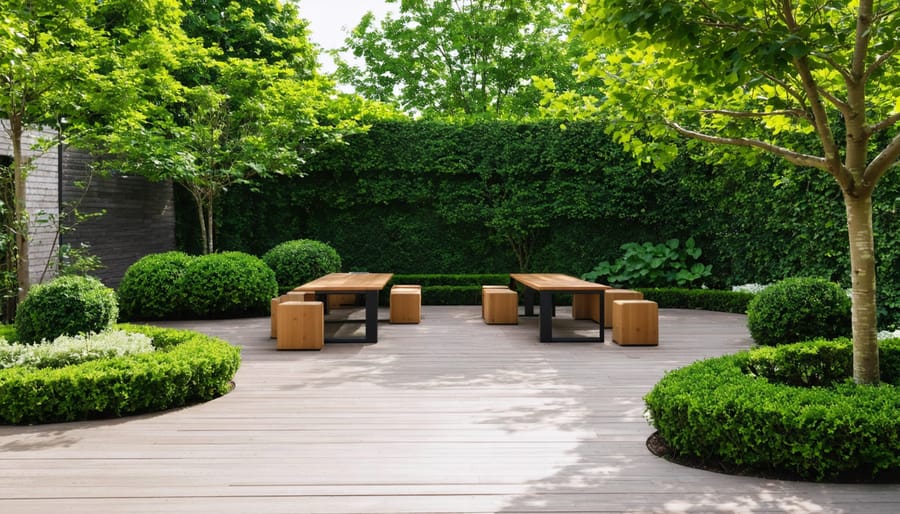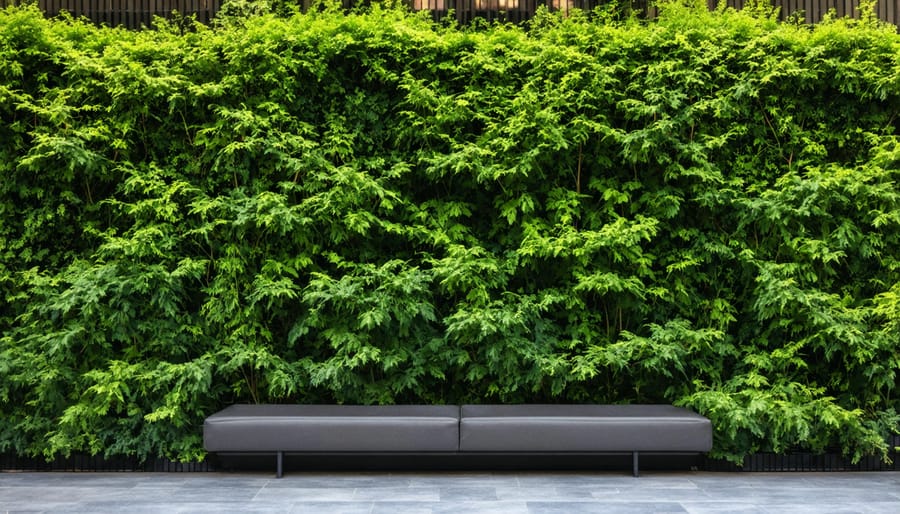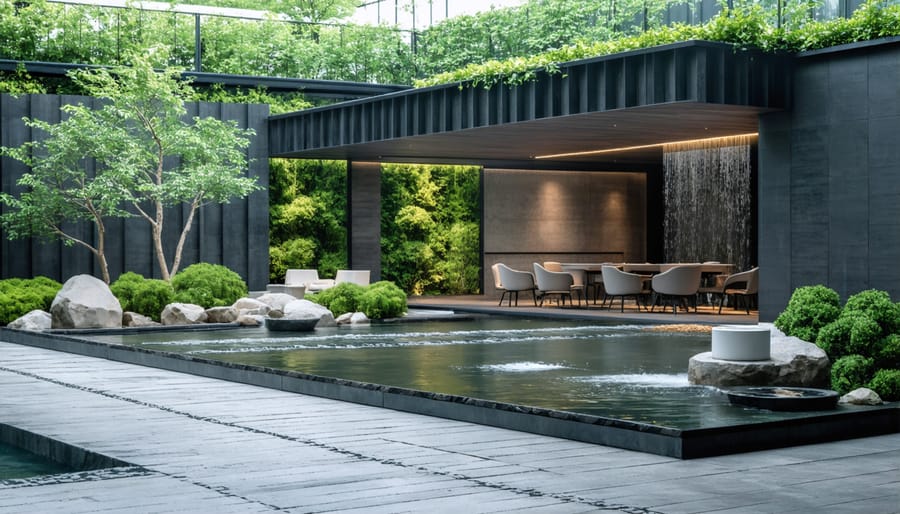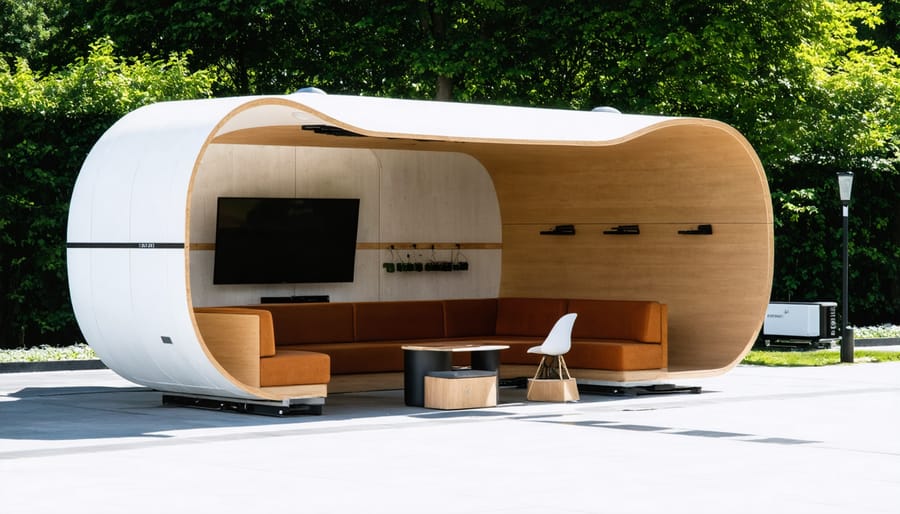Transform Your Outdoor Workspace: Smart Sound Design That Actually Works

Transform outdoor spaces into productive work environments by strategically placing sound-absorbing vegetation, installing acoustic barriers, and implementing strategic zoning techniques. Managing outdoor noise requires a thoughtful blend of natural and structural solutions that work in harmony with the environment. Position dense hedgerows and mature trees along property boundaries to create natural sound barriers while enhancing visual appeal. Install weather-resistant acoustic panels that complement existing architecture, reducing sound reflection and creating comfortable conversation zones. Layer different sound management techniques—combining planted borders, water features, and specialized outdoor furniture—to achieve optimal acoustic control without sacrificing the outdoor atmosphere. These practical approaches not only minimize noise pollution but also create inviting spaces that boost productivity and well-being, making outdoor workspaces as functional as their indoor counterparts.
Natural Sound Barriers: Working With Your Environment
Strategic Vegetation Placement
Strategic placement of vegetation offers a natural and aesthetically pleasing solution for managing outdoor acoustics. When incorporated as natural workspace elements, trees, shrubs, and plants can significantly reduce noise levels while enhancing the visual appeal of your outdoor space.
Dense evergreen trees are particularly effective at absorbing and deflecting sound waves. Plant them in a staggered formation along property lines or noise sources for maximum effectiveness. Thick-leaved shrubs like laurel, holly, or boxwood create excellent sound barriers when planted closely together, forming living walls that dampen ambient noise.
For immediate impact, consider fast-growing varieties like bamboo or arborvitae, which can quickly establish sound-absorbing barriers. Layer different heights of vegetation, starting with tall trees at the back, medium-sized shrubs in the middle, and ground cover plants in front. This multi-tiered approach not only maximizes sound absorption but also creates visual depth in your landscape.
Remember to maintain adequate spacing between plants to ensure healthy growth while maintaining their acoustic benefits. Regular pruning helps maintain density, which is crucial for sound absorption. Consider seasonal changes when selecting plants – evergreen varieties provide year-round acoustic protection, while deciduous plants may offer varying levels of sound reduction throughout the seasons.

Water Features as Sound Masks
Water features offer a natural and elegant solution to mask unwanted noise in outdoor spaces while creating a serene atmosphere. The sound of flowing water produces what acoustics experts call “white noise,” which helps diminish the impact of disruptive sounds like traffic or neighboring conversations.
Fountains are particularly effective as sound masks because they generate consistent background noise that’s both pleasant and adjustable. The height from which water falls and the surface it lands on can be modified to create different sound profiles. For example, water falling onto stone produces a bright, crisp sound, while water cascading into a pool creates a deeper, more soothing tone.
When selecting a water feature, consider the size of your space and the level of noise you need to mask. Small tabletop fountains work well for intimate seating areas, while larger wall fountains or cascading waterfalls are better suited for bigger spaces or areas with more significant noise concerns.
For optimal sound masking, position water features strategically between noise sources and your primary activity areas. Multiple smaller fountains distributed throughout your space can provide more even coverage than a single large feature. Remember to maintain a comfortable sound level – the goal is to create gentle background noise, not to overwhelm the space with loud water sounds.

Structural Solutions for Sound Control
Pergolas and Overhead Structures
Pergolas and overhead structures play a crucial role in managing outdoor acoustics while adding architectural interest to your space. These elevated elements serve a dual purpose: they help control sound reflection patterns and create opportunities for incorporating sound-absorbing materials overhead.
When strategically designed, a pergola can break up sound waves that would otherwise bounce between parallel surfaces. The spacing and arrangement of rafters and beams can diffuse sound energy, reducing echo and reverberation in your outdoor area. For enhanced acoustic benefits, consider adding fabric panels or outdoor curtains between pergola beams, which absorb sound while providing adjustable shade.
Natural elements like climbing vines and hanging plants on your pergola not only create a beautiful aesthetic but also contribute to sound absorption. Dense foliage helps capture and dissipate sound waves, particularly higher frequencies that can make outdoor spaces feel harsh and noisy.
For maximum acoustic benefit, consider incorporating weather-resistant acoustic panels into your pergola design. These can be disguised as decorative elements while effectively managing sound. Retractable canopy systems offer flexibility, allowing you to adjust both shade and acoustic properties based on your needs.
Remember to balance acoustic treatments with aesthetic appeal. A well-designed pergola should enhance your outdoor space visually while creating a more comfortable acoustic environment for work or relaxation.
Wall and Fence Solutions
When it comes to managing outdoor noise, walls and fences serve as your first line of defense. The key to creating effective sound barrier solutions lies in choosing the right materials and design. Solid wood fencing, particularly cedar or redwood, offers both natural beauty and impressive sound-dampening properties. For maximum effectiveness, opt for boards that are at least 1.5 inches thick and install them with minimal gaps.
Concrete or stone walls provide superior sound blocking capabilities and can be enhanced with climbing plants or decorative elements for visual appeal. Modern composite fencing materials combine durability with excellent acoustic properties, making them a practical choice for busy areas.
Height matters significantly in sound control – a barrier should ideally be tall enough to break the line of sight between the noise source and your workspace. Consider adding mass-loaded vinyl sheets between fence posts or incorporating sound-absorbing panels into your existing fence design for enhanced performance.
For a more natural approach, creating a double barrier with vegetation between two fence lines can significantly reduce noise while adding greenery to your space. Remember to check local building codes and HOA regulations before starting your project, as height restrictions may apply to fence installations.
Floor Materials and Sound Absorption
The ground beneath your feet plays a crucial role in managing outdoor acoustics. Different flooring materials can either absorb sound waves or reflect them, significantly impacting the acoustic environment of your outdoor space.
Soft, porous materials like grass and mulch are excellent sound absorbers. Natural grass lawns can reduce noise levels by up to 20%, making them an ideal choice for areas where sound control is a priority. Mulch offers similar benefits while adding aesthetic appeal to your landscape.
Gravel and loose stone surfaces present an interesting acoustic profile. While they can create some noise when walked upon, their irregular surface actually helps break up sound waves and reduce overall noise reflection. For a more permanent solution, consider rubber pavers or cork flooring, which provide superior sound absorption while maintaining durability for outdoor use.
Concrete and stone pavers, while popular choices for outdoor spaces, tend to reflect sound rather than absorb it. However, you can mitigate this by incorporating strategic placement of sound-absorbing materials around these hard surfaces. Consider creating borders of vegetation or using textured patterns in your hardscaping to help diffuse sound waves.
For workspace areas, composite decking materials offer a balanced solution, providing both durability and moderate sound absorption properties. These materials can be particularly effective when combined with underlayment designed specifically for acoustic control.
Smart Design Tips for Different Workspace Types
Open Meeting Areas
Creating effective outdoor collaborative spaces requires careful consideration of acoustic elements to ensure comfortable and productive interactions. The key is to strike a balance between openness and sound control, making the space inviting while minimizing noise disruption.
Natural elements play a crucial role in managing acoustics in open meeting areas. Strategic placement of trees and shrubs not only provides visual privacy but also helps absorb and diffuse sound waves. Consider incorporating water features, which can create a pleasant white noise effect that masks unwanted sounds while contributing to a calming atmosphere.
The layout of your meeting area significantly impacts its acoustic performance. Position seating arrangements away from noise sources like streets or mechanical equipment. Using curved or angled layouts rather than straight lines helps prevent sound from traveling directly between spaces. Consider installing pergolas or partial walls that can help contain conversations while maintaining an open-air feel.
Surface materials matter too. Opt for sound-absorbing ground covers like grass or rubber mulch instead of hard surfaces that reflect sound. Outdoor rugs and cushioned furniture can further help reduce sound reflection. If using hard surfaces for practical reasons, break them up with planters or decorative elements to disrupt sound waves.
For year-round functionality, retractable awnings or removable panels can provide acoustic flexibility while protecting against weather conditions. These adaptable solutions allow you to modify the space’s acoustic properties as needed while maintaining its outdoor character.
Individual Work Pods
Individual work pods offer an innovative solution for creating private, acoustically-controlled spaces in outdoor settings. These standalone structures combine the benefits of ergonomic outdoor workspace design with effective sound management, making them perfect for focused work or virtual meetings.
To maximize acoustic performance, work pods should incorporate several key features. Start with double-paned windows and weather-sealed doors to minimize external noise penetration. Adding acoustic panels to interior walls helps absorb sound reflections, while strategic placement of soft materials like carpeting or cushions further enhances sound control.
The positioning of your work pod is crucial for optimal acoustics. Consider placing it away from noisy areas like streets or play spaces, and use natural barriers such as hedges or trees to create additional sound buffers. Elevating the pod slightly off the ground can reduce vibration transfer and improve overall sound isolation.
For enhanced functionality, integrate ventilation systems that operate quietly and include power outlets for necessary equipment. Weather-resistant materials ensure durability while maintaining acoustic integrity. Many homeowners find success with modular pod designs that can be customized to fit their specific needs and space requirements.
Remember to include adequate lighting and temperature control features to create a comfortable working environment throughout the year. These elements, combined with proper acoustic treatment, transform outdoor work pods into productive, private spaces perfect for remote work or creative pursuits.

Mixed-Use Spaces
Creating harmonious outdoor spaces that serve multiple purposes requires careful acoustic planning. When designing areas meant for both social gatherings and quiet activities, consider implementing zones that naturally separate different noise levels. For example, position conversation areas away from meditation spaces using strategic landscaping and physical barriers.
Natural sound barriers like dense hedges, bamboo screens, or living walls can effectively divide spaces while maintaining an organic feel. These green solutions not only help manage acoustics but also enhance the visual appeal of your outdoor area. Consider incorporating water features strategically – they can mask unwanted noise while creating a pleasant ambient sound that doesn’t interfere with conversations.
Surface materials play a crucial role in mixed-use spaces. Use sound-absorbing materials like rubber mulch or cork flooring in areas designated for active pursuits, while maintaining harder surfaces where sound reflection is desired, such as in performance or speaking areas. Modular furniture and movable screens offer flexibility to adjust the acoustic environment as needed.
Timing can also help manage mixed uses effectively. Schedule louder activities during peak hours and reserve quieter times for activities requiring more focus or relaxation. Creating a simple schedule for different uses can help everyone enjoy the space without acoustic conflicts.
Remember to include clear signage or visual cues that indicate designated quiet zones versus social areas, helping users naturally regulate their noise levels according to the space they’re in.
Creating an acoustically balanced outdoor space doesn’t have to be a complex endeavor. By implementing the strategies we’ve discussed, you can significantly improve sound quality while maintaining the natural beauty of your outdoor environment. Start with simple solutions like strategic placement of sound-absorbing materials and vegetation, then gradually incorporate more permanent features as needed.
Remember that successful outdoor acoustics management combines both sound reduction and enhancement techniques. Whether you’re creating a peaceful garden sanctuary or a functional outdoor workspace, focus first on addressing the most disruptive noise sources in your space. Consider installing physical barriers where necessary, and don’t underestimate the power of natural elements like trees and shrubs in your acoustic design.
Take time to observe how sound travels in your specific outdoor area throughout different times of the day. This understanding will help you make more informed decisions about placement and materials. Start with small changes and evaluate their impact before making larger investments.
For best results, consider working with a landscape professional who understands acoustic principles. They can help you create a comprehensive plan that integrates both aesthetic and functional elements. Remember to maintain any installed features regularly to ensure their continued effectiveness in managing outdoor acoustics.
By taking these steps, you’ll be well on your way to creating an outdoor space that not only looks beautiful but sounds perfect too.

